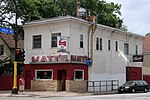Lake Street/Midtown station, also referred locally as just Midtown station, is a Blue Line light rail station in Minneapolis, Minnesota, United States.
This elevated station spans over Lake Street along the west side of Minnesota State Highway 55 (Hiawatha Avenue). This is a center-platform station. Along with the Franklin Avenue station, the Lake Street/Midtown station is one of the two above-grade stations on the Blue Line. Service began at this station when the Blue Line opened on June 26, 2004.
The Midtown Station is one of four stations immediately adjacent to Hiawatha Avenue. Others include 38th Street Station, 46th Street Station, and 50th Street Station. The Hiawatha Corridor features a wide variety of architecture including grain elevators, subsidized housing, and well-established neighborhoods, such as Longfellow and Corcoran.
Just north of the station, the Blue Line crosses over Hiawatha Avenue on a concrete box girder flyover before returning to grade level.
The seasonal Midtown Farmers' Market operates weekly on a space immediately adjacent to the station. The market features produce, meat, cheese, bread, eggs, flowers, crafts, hot food, music and family-oriented entertainment.
Upon opening, the station hosted a 170-space park and ride lot immediately southwest of the station, leased from Anishinabe Academy elementary school.
The lot was planned only as a temporary amenity and to be phased out as other lots opened outside the urban core. It was regularly filled beyond capacity, with parking overflowing into aisles and onto nearby streets. Residents have complained about the lack of parking (and specifically the overflow onto streets) at neighborhood meetings. Crime has also been an intermittent problem in the parking lot, with victims attributing the lot's poor overhead lighting as a major contributing factor. Local residents and the neighborhood organization have called upon Metro Transit to improve the lighting situation, but the process has been complicated by the fact that Metro Transit does not own the lot, but merely leases it from the public school district. This lot was the only park and ride lot on the Blue Line within the city of Minneapolis. The lot closed March 7, 2015 for redevelopment. There are over 2,500 park and ride spaces at Fort Snelling station and 28th Avenue station at the southern end of the Blue Line.
In July 2008, local residents teamed up with Metro Transit and Xcel Energy to decorate several electric boxes situated between the station and the park and ride lot. The murals painted on the structures depict grain stalks on a blue sky, and are intended to represent the Midtown Farmers' Market held adjacent to the station. Local residents also encouraged Metro Transit to install sidewalks and stairs along lines of bare dirt where riders frequently cut through a sloping grassy area. This improved station access and reduced erosion problems.This station is planned to be served as the terminus of the Minneapolis Streetcar System's Midtown Greenway Line .









